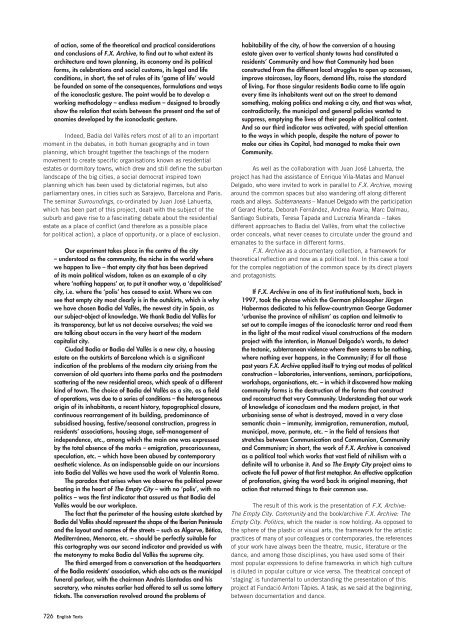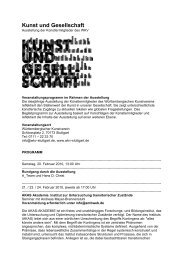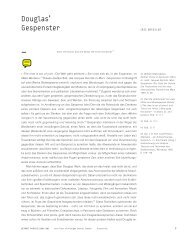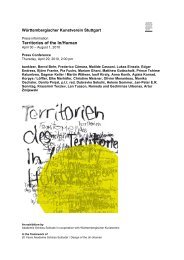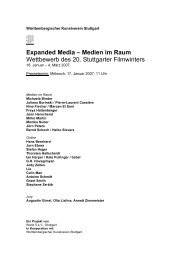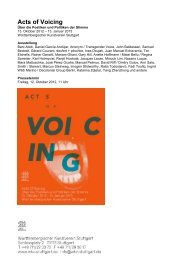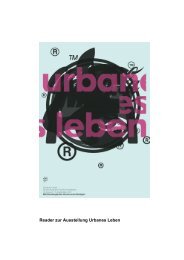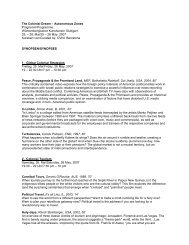English Texts
English Texts
English Texts
Create successful ePaper yourself
Turn your PDF publications into a flip-book with our unique Google optimized e-Paper software.
of action, some of the theoretical and practical considerations<br />
and conclusions of F.X. Archive, to find out to what extent its<br />
architecture and town planning, its economy and its political<br />
forms, its celebrations and social customs, its legal and life<br />
conditions, in short, the set of rules of its ‘game of life’ would<br />
be founded on some of the consequences, formulations and ways<br />
of the iconoclastic gesture. The point would be to develop a<br />
working methodology – endless medium – designed to broadly<br />
show the relation that exists between the present and the set of<br />
anomies developed by the iconoclastic gesture.<br />
Indeed, Badia del Vallès refers most of all to an important<br />
moment in the debates, in both human geography and in town<br />
planning, which brought together the teachings of the modern<br />
movement to create specific organisations known as residential<br />
estates or dormitory towns, which drew and still define the suburban<br />
landscape of the big cities, a social democrat inspired town<br />
planning which has been used by dictatorial regimes, but also<br />
parliamentary ones, in cities such as Sarajevo, Barcelona and Paris.<br />
The seminar Surroundings, co-ordinated by Juan José Lahuerta,<br />
which has been part of this project, dealt with the subject of the<br />
suburb and gave rise to a fascinating debate about the residential<br />
estate as a place of conflict (and therefore as a possible place<br />
for political action), a place of opportunity, or a place of exclusion.<br />
Our experiment takes place in the centre of the city<br />
– understood as the community, the niche in the world where<br />
we happen to live – that empty city that has been deprived<br />
of its main political wisdom, taken as an example of a city<br />
where ‘nothing happens’ or, to put it another way, a ‘depoliticised’<br />
city, i.e. where the ‘polis’ has ceased to exist. Where we can<br />
see that empty city most clearly is in the outskirts, which is why<br />
we have chosen Badia del Vallès, the newest city in Spain, as<br />
our subject-object of knowledge. We thank Badia del Vallès for<br />
its transparency, but let us not deceive ourselves; the void we<br />
are talking about occurs in the very heart of the modern<br />
capitalist city.<br />
Ciudad Badía or Badia del Vallès is a new city, a housing<br />
estate on the outskirts of Barcelona which is a significant<br />
indication of the problems of the modern city arising from the<br />
conversion of old quarters into theme parks and the postmodern<br />
scattering of the new residential areas, which speak of a different<br />
kind of town. The choice of Badia del Vallès as a site, as a field<br />
of operations, was due to a series of conditions – the heterogeneous<br />
origin of its inhabitants, a recent history, topographical closure,<br />
continuous rearrangement of its building, predominance of<br />
subsidised housing, festive/seasonal construction, progress in<br />
residents’ associations, housing stage, self-management of<br />
independence, etc., among which the main one was expressed<br />
by the total absence of the marks – emigration, precariousness,<br />
speculation, etc. – which have been abused by contemporary<br />
aesthetic violence. As an indispensable guide on our incursions<br />
into Badia del Vallès we have used the work of Valentín Roma.<br />
The paradox that arises when we observe the political power<br />
beating in the heart of The Empty City – with no ‘polis’, with no<br />
politics – was the first indicator that assured us that Badia del<br />
Vallès would be our workplace.<br />
The fact that the perimeter of the housing estate sketched by<br />
Badia del Vallès should represent the shape of the Iberian Peninsula<br />
and the layout and names of the streets – such as Algarve, Bética,<br />
Mediterránea, Menorca, etc. – should be perfectly suitable for<br />
this cartography was our second indicator and provided us with<br />
the metonymy to make Badia del Vallès the supreme city.<br />
The third emerged from a conversation at the headquarters<br />
of the Badía residents’ association, which also acts as the municipal<br />
funeral parlour, with the chairman Andrés Llantadas and his<br />
secretary, who minutes earlier had offered to sell us some lottery<br />
tickets. The conversation revolved around the problems of<br />
habitability of the city, of how the conversion of a housing<br />
estate given over to vertical shanty towns had constituted a<br />
residents’ Community and how that Community had been<br />
constructed from the different local struggles to open up accesses,<br />
improve staircases, lay floors, demand lifts, raise the standard<br />
of living. For those singular residents Badía came to life again<br />
every time its inhabitants went out on the street to demand<br />
something, making politics and making a city, and that was what,<br />
contradictorily, the municipal and general policies wanted to<br />
suppress, emptying the lives of their people of political content.<br />
And so our third indicator was activated, with special attention<br />
to the ways in which people, despite the nature of power to<br />
make our cities its Capital, had managed to make their own<br />
Community.<br />
As well as the collaboration with Juan José Lahuerta, the<br />
project has had the assistance of Enrique Vila-Matas and Manuel<br />
Delgado, who were invited to work in parallel to F.X. Archive, moving<br />
around the common spaces but also wandering off along different<br />
roads and alleys. Subterraneans – Manuel Delgado with the participation<br />
of Gerard Horta, Deborah Fernández, Andrea Avaria, Marc Dalmau,<br />
Santiago Subirats, Teresa Tapada and Lucrezia Miranda – takes<br />
different approaches to Badia del Vallès, from what the collective<br />
order conceals, what never ceases to circulate under the ground and<br />
emanates to the surface in different forms.<br />
F.X. Archive as a documentary collection, a framework for<br />
theoretical reflection and now as a political tool. In this case a tool<br />
for the complex negotiation of the common space by its direct players<br />
and protagonists.<br />
If F.X. Archive in one of its first institutional texts, back in<br />
1997, took the phrase which the German philosopher Jürgen<br />
Habermas dedicated to his fellow-countryman George Gadamer<br />
‘urbanise the province of nihilism’ as caption and leitmotiv to<br />
set out to compile images of the iconoclastic terror and read them<br />
in the light of the most radical visual constructions of the modern<br />
project with the intention, in Manuel Delgado’s words, to detect<br />
the tectonic, subterranean violence where there seems to be nothing,<br />
where nothing ever happens, in the Community; if for all those<br />
past years F.X. Archive applied itself to trying out modes of political<br />
construction – laboratories, interventions, seminars, participations,<br />
workshops, organisations, etc. – in which it discovered how making<br />
community forms is the destruction of the forms that construct<br />
and reconstruct that very Community. Understanding that our work<br />
of knowledge of iconoclasm and the modern project, in that<br />
urbanising sense of what is destroyed, moved in a very close<br />
semantic chain – immunity, immigration, remuneration, mutual,<br />
municipal, move, permute, etc. – in the field of tensions that<br />
stretches between Communication and Communion, Community<br />
and Communism; in short, the work of F.X. Archive is conceived<br />
as a political tool which works that vast field of nihilism with a<br />
definite will to urbanise it. And so The Empty City project aims to<br />
activate the full power of that first metaphor. An effective application<br />
of profanation, giving the word back its original meaning, that<br />
action that returned things to their common use.<br />
The result of this work is the presentation of F.X. Archive:<br />
The Empty City. Community and the book/archive F.X. Archive: The<br />
Empty City. Politics, which the reader is now holding. As opposed to<br />
the sphere of the plastic or visual arts, the framework for the artistic<br />
practices of many of your colleagues or contemporaries, the references<br />
of your work have always been the theatre, music, literature or the<br />
dance, and among those disciplines, you have used some of their<br />
most popular expressions to define frameworks in which high culture<br />
is diluted in popular culture or vice versa. The theatrical concept of<br />
‘staging’ is fundamental to understanding the presentation of this<br />
project at Fundació Antoni Tàpies. A task, as we said at the beginning,<br />
between documentation and dance.<br />
726 <strong>English</strong> <strong>Texts</strong>


